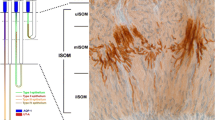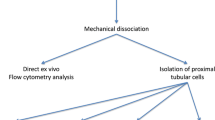Abstract
The Madin-Darby canine kidney (MDCK) cell line has been proposed as a model for studying intercalated (IC) cells of the renal cortical collecting duct. The IC cells are characterized by peanut lectin (PNA) binding capacity, carbonic anhydrase (CA) activity and Cl-−HCO -3 exchange mediated by a band 3-related protein. It has been suggested that these properties are also expressed in MDCK cells. So far however, the nature of the specific protein involved in Cl-−HCO -3 exchange, the type of CA isozyme and the relationship between these two characteristics and PNA binding, have not been investigated in MDCK cells by immunocytochemical methods. Using two antibodies raised against human erythrocyte band 3 protein and two against human erythrocyte CA I and II isozymes, our study provides evidence that a protein related to band 3 is expressed in about 5% of cultured MDCK cells; these band 3-positive cells do not bind PNA and are not reactive for CAI or CAII. About 30% of the MDCK cells bind PNA, two-thirds of which are also CAII-positive. A majority (about 65%) of MDCK cells is not reactive for the three markers used; their density is increased after incubation with aldosterone. These data indicate (i) that the Cl-−HCO -3 exchanger of the MDCK cells could be related to human erythrocyte band 3, (ii) that the CA activity of the MDCK cell line bears antigenic identity with the erythrocyte CA II isozyme and (iii) that the latter is always co-localized with PNA binding. These results provide immunocytochemical evidence for the heterogeneity of the MDCK cell line, which might reflect the cellular heterogeneity encountered in the renal cortical collecting duct. Our data also indicate that clonal selection will be required for future functional studies of the MDCK cells.
Similar content being viewed by others
References
Adelsberg JS van, Edwards JC, Al-Awqati Q (1993) The apical Cl/HCO3 exchanger of β intercalated cells. J Biol Chem 268:11283–11289
Al-Awqati Q, Beauwens R (1992) Cellular mechanisms of H+ and HCO -3 transport in tight urinary epithelia. In: Windhager EE (ed) Handbook of Physiology, Section 8: Renal Physiology. Oxford University Press, New York, Oxford, pp 323–350
Barker G, Simmons NL (1981) Identification of two strains of cultured canine renal epithelial cells (MDCK cells) which display entirely different physiological properties. Quart J Exp Physiol 66:61–72
Beauwens R, Fisher RS, Crabbé J (1990) Sodium transport by “tight” amphibian epithelia. In: Kinne RKH (ed) Basic principles in transport. Karger, Basel, pp 1–57
Cabantchik ZI, Knauf PA, Rothstein A (1978) The anion transport system of the red blood cell. Biochim Biophys Acta 515:239–302
Czerwinski M, Wasniowska K, Steuden I, Duk M, Wiedlocha A, Lisowska E (1988) Degradation of the human erythrocyte membrane band 3 studied with the monoclonal antibody directed against an epitope on the cytoplasmic fragment of band 3. Eur J Biochem 174:647–654
Devuyst O, Rott R, Denef JF, Crabbé J, Katz U (1993) Localization of a band 3-related protein in the mitochondria-rich cells of amphibian skin epithelium. Biol Cell 78:217–221
Drenckhahn D, Oelmann M, Schaaf P, Wagner M, Wagner S (1987) Band 3 is the basolateral anion exchanger of dark epithelial cells of turtle urinary bladder. Am J Physiol 252:C570-C574
Fukuda M, Eshdat Y, Tarone G, Marchesi VT (1978) Isolation and characterization of peptides derived from the cytoplasmic fragment of band 3, the predominant intrinsic membrane protein of the human erythrocyte. J Biol Chem 253:2419–2428
Hansson HPJ (1967) Histochemical demonstration of carbonic anhydrase activity. Histochemie 11:112–128
Holthöfer H, Schulte BA, Pasternack G, Siegel GJ, Spicer SS (1987) Immunocytochemical characterization of carbonic anhydraserich cells in the rat kidney collecting duct. Lab Invest 57:150–156
Kay MMB, Tracey CM, Goodman JR, Cone JC, Bassel PS (1983) Polypeptides immunologically related to band 3 are present in nucleated somatic cells. Proc Natl Acad Sci USA 80:6882–6886
Kellokumpu S, Neff L, Jämsä-Kellokumpu S, Kopito R, Baron R (1988) A 115-kD polypeptide immunologically related to erythrocyte band 3 is present in Golgi membranes. Science 242:1308–1311
Kersting U, Joha H, Steigner W, Gassner B, Gstraunthaler G, Pfaller W, Oberleithner H (1989) Fusion of cultured dog kidney (MDCK) cells. I. Technique, fate of plasma membranes and of cell nuclei. J Membr Biol 111:37–48
Kersting U, Pfaller W, Gstraunthaler G, Steigner W, Oberleithner H (1990) Differentiation of MDCK cells: structure-function relationship using lectin binding. Kidney Int 37:1163
Kersting U, Schwab A, Treidtel M, Pfaller W, Gestraunthaler G, Steigner W, Oberleithner H (1993) Differentiation of Madin-Darby canine kidney cells depends on cell culture conditions. Cell Physiol Biochem 3:42–55
Kohn OF, Mitchell PP, Steinmetz PR (1990) Characteristics of apical Cl-HCO3 exchanger of bicarbonate-secreting cells in turtle bladder. Am J Physiol 258:F9-F14
Kopito RR (1990) Molecular biology of the anion exchanger gene family. Int Rev Cytol 123:177–199
Kurtz I, Golchini K (1987) Na+-independent Cl-/HCO -3 exchange in Madin-Darby canine kidney cells. J Biol Chem 262:4516–4520
Larsen EH (1991) Chloride transport by high-resistance epithelia. Physiol Rev 71:235–283
Lever JE (1979) Inducers of mammalian cell differentiation stimulate dome formation in a differentiated kidney epithelial cell line (MDCK). Proc Natl Acad Sci USA 76:1323–1327
Ludens JH, Vaughn DA, Mawe RC, Fanestil DD (1978) Specific binding of deoxycorticosterone by canine kidney cells in culture. J Steroid Biochem 9:17–21
Lux SE, John KM, Kopito RR, Lodish HF (1989) Cloning and characterization of band 3, the human erythrocyte anion-exchange protein (AE1). Proc Natl Acad Sci USA 86:9089–9093
Madin SH, Darby NB Jr (1958) As catalogued in: American type culture collection catalogue of strains. Library of Congress, Rockville, MD, vol 2:574–576
Madsen KM, Tisher CC (1986) Structural-functional relationship along the distal nephron. Am J Physiol 250:F1-F15
Maren TH (1967) Carbonic anhydrase: chemistry, physiology, and inhibition. Physiol Rev 47:595–781
Meier KE, Snavely MD, Brown SL, Brown JH, Insel PA (1983) 237-1 receptor expression in the Madin-Darby canine kidney epithelial cell line. J Cell Biol 97:405–415
Nakazato Y, Suzuki H, Saruta T (1989) Characterization of subclones of Madin-Darby canine kidney renal epithelial cell line. Biochim Biophys Acta 1014:57–65
Nelson N (1983) Structure and synthesis of chondroblast ATPase. Methods Enzymol 97:510–523
Oberleithner H (1991) Acute aldosterone action in renal target cells. Cell Physiol Biochem 1:2–12
Oberleithner H, Vogel U, Kersting U (1990a) Madin-Darby canine kidney cells. I. Aldosterone-induced domes and their evaluation as a model system. Pflügers Arch 416:526–532
Oberleithner H, Vogel U, Kersting U, Steigner W (1990b) Madin-Darby canine kidney cells. II. Aldosterone stimulates Na+/H+ and Cl-/HCO -3 exchange. Pflügers Arch 416:533–539
Oberleithner H, Steigner W, Silbernagl S, Vogel U, Gstraunthaler G Pfaller W (1990c) Madin-Darby canine kidney cells. III. Aldosterone stimulates and apical H+/K+ pump. Pflügers Arch 416:540–547
Pfaller W, Gstraunthaler G, Kersting U, Oberleithner H (1989) Carbonic anhydrase activity in Madin-Darby canine kidney cells. Renal Physiol Biochem 12:328–337
Pfaller W, Steigner W, Gstraunthaler G, Kersting U, Oberleithner H (1993) Low pH and hyperosmolality determine the differentiation of MDCK cells typical for the outer medullary collecting duct. Cell Physiol Biochem 3:56–67
Schuster VL (1993) Function and regulation of collecting duct intercalated cells. Ann Rev Physiol 55:267–288
Simmons NL (1981) Stimulation of Cl- secretion by exogenous ATP in cultured MDCK epithelial monolayers. Biochim Biophys Acta 646:231–242
Valentich JD (1981) Morphological similarities between the dog kidney cell line MDCK and the mammalian cortical collecting tubule. Ann NY Acad Sci 372:384–405
Verlander JW, Madsen KM, Low PS, Allen DP, Tisher CC (1988) Immunocytochemical localization of band 3 protein in the rat collecting duct. Am J Physiol 255:F115-F125
Wagner S, Vogel R, Lietzke R, Koob R, Drenckhahn D (1987) Immunocytochemical characterization of a band 3-like anion exchanger in collecting duct of human kidney. Am J Physiol 253:F213-F221
Yang CPH, Cobb MH, Jefferson DM, Scott WN (1981) Effect of mineralocorticoids on RNA and protein synthesis in MDCK cells. Ann NY Acad Sci 342:470–472
Author information
Authors and Affiliations
Rights and permissions
About this article
Cite this article
Devuyst, O., Beauwens, R., Denef, JF. et al. Subtypes of Madin-Darby canine kidney (MDCK) cells defined by immunocytochemistry: Further evidence for properties of renal collecting duct cells. Cell Tissue Res 277, 231–237 (1994). https://doi.org/10.1007/BF00327770
Received:
Accepted:
Issue Date:
DOI: https://doi.org/10.1007/BF00327770




